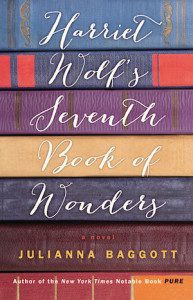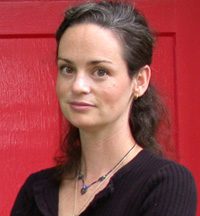
In Julianna Baggott’s universe, crazy is the new sane. The author of over 20 books, Baggott knows crazy. She explored the dissonance of sanity in Lizzie Borden in Love. These persona poems smolder with the oracular voices of women on the edge. Abe’s widow not so quietly loses it among the loonies in “Mary Todd on Her Deathbed,” and, pre-Ted Talk, we get why Monica Lewinsky felt a tad gaslighted.
In Baggott’s new work of fiction, she returns to this theme of women on the edge. Harriet Wolf’s Seventh Book of Wonders tells the story of three generations of women as they navigate the world with all their neuroses showing. Novelist Harriet Wolf, her daughter Eleanor, and her granddaughters Ruth and Tilton are distinct and developed narrators with defined quirks. Yet, we can’t help but love them for their vulnerabilities and the way they mirror the zeitgeist.
Harriet Wolf, the matriarch, born in 1900 is “mute and sallow and already a bleeder.” She is hastily shuffled off to the Maryland School for Feeble Minded Children by her father; her mother’s told she is dead. As a child, Harriet meets her true love in the laundry room: “I got down on my hands and knees and looked underneath to find the face of Eppitt Clapp. It was one to grow into. His nose, his lips, and his eyes crowded his face, so there wasn’t much face left. The slightest emotion caused a lot of action.”
Harriet, tragically, will have to keep Eppitt secret. The secret child, the secret lover, and the mother withholding secrets from her daughter become tropes in the book. Yet Harriet is aware that her birth is contemporaneous with the publication of Freud’s Interpretation of Dreams. And as we know from Sigmund, what’s repressed will certainly rise again some way, somehow.

Like the ink blots in a Rorschach, Harriet isn’t what she seems—rather than feeble-minded, she is a child genius according to an I.Q. test. This Wolf doesn’t quite run with wolves, but she will eventually ride on a motorcycle with a lion in a motordrome, tangentially run with the mob, be involuntarily committed to an insane asylum for a few years, and write the six highly popular books chronicling the love between the characters Daisy and Weldon. The charm for Wolf’s devoted, even fanatical, readers is that Daisy and Weldon mature as their audience does, and each book morphs into its age-appropriate literary form: from fairy tale to teenage dystopia, from early adult realism through mid-life modernism to post-modern old age. By the time of her death, Harriet is infamous for the missing last book, the seventh in the “Wonder Series.” The secret book preoccupies all the characters, and becomes the family truth that can no longer be repressed.
Still in the dark about her own parentage, Harriet’s daughter Eleanor is an embittered single mom who just survived a heart attack. A mid-century realist, she’s impatient with her mother’s fantastical gorging: “I don’t like fictional stories,” she says. “My mother ferreted through reality for parts to weld together to tell her untrue stories, which always struck me as careless and selfish.” Still recoiling from the shock of her husband’s desertion, she’s an over-protective helicopter parent to one of her two daughters, Tilton. If the early twentieth century forced children to be orphans with a pull-up-your-bootstraps mentality, then the late twentieth century produced its opposite: children so over-mothered, they never leave home.
Tilton and her sister Ruth voice the book’s final chapters: in them we hear the pain of Eleanor’s cynicism. Tilton is hypersensitive and hyper allergic to the chaos of the early twenty-first century and also sensitive to the presence of her dead grandmother, whom she calls “Wee-ette.”
“No one knows this house as she knows it, as I know it,” Tilton says. “A world is tucked in here. A universe.” The Wolf house, where Harriet was born and died, symbolizes maternal ambivalence. While Eleanor both infantilized and protected Tilton, she dispelled Ruth, who had to find her own way.
Ultimately, Baggott’s matrilineal tale has much to recommend it: a love story, cross-dressing mobsters, and winsome details that ache with particularity. For instance, both Harriet and Tilton collect and secret away their “pacts”: bits of strings, marked with the date and the names of the pact-holders. Baggott brings to life the damaged children and the “hopeless” cases in the early twentieth century. The ultimate “book of wonder,” Harriet’s life story, demonstrates the resilience of unique spirits that go forth in the world, mothering themselves, and rewriting the world to give it a measure of sanity.




